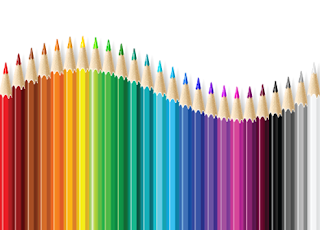Colored pencils are so rewarding ! With few tools and just a little effort, you can make beautiful illustrations for your cards, scrapbook pages, gift bags, tags and more.
Colored Pencil Basics
As with other art supplies, the price of colored pencils often indicate their quality. The better pencils have a truer color tone in their use. Some are sold as individual pencils. Others are sold in packs.
Always store your colored pencils upright in a container. The lead in these pencils can be very fragile. If they are dropped, the lead will break.
Colored Pencil Accessories
Erasers
Unlike other pencils, you are not able to use regular erasers like rubber or vinyl. It will melt the wax pigment and ruin the grain of the paper. Instead, you can use a kneaded eraser. It is good to use a small amount of pigment. You can pinch or knead it to the shape you require. You can press it lightly to remove pigment. When the eraser gets "dirty" you can knead it to get a clean surface.
Sharpeners
You can achieve different effects with your pencils, depending how sharp or dull your colored pencils are.
There is also a small electric pencil eraser that is popular among colored pencil artists. Generally, the rule of thumb is that you will want to keep your colored pencils sharpened. A sharp pencil will give you a better layer of color. You can use a hand held sharpener, but an electric sharpener will give you better results.
A sandpaper pad will refine your colored pencil point to its' best advantage.
Other Colored Pencil Accessories
- A dust brush will help you remove any residue from your projects
- A blending stump helps you create soft blends
- A pencil extender helps you use your colored pencils right to the end
- A triangle helps you make straight lines
Paper For Colored Paper
Textured papers are always best for any kind of colored pencil artwork. The rough grain of textured paper accepts the color and the most pigment over a smoother paper. Look for textured water color options. If you are new to colored pencils, start with a medium grain to start. For quick studies or practice pages, use a water color sketch book.
Color Tips For Colored Pencils
Colored pencils are considered transparent, so instead of mixing colors like in paints, you create blends by laying one color on top of the other,
Value is the term used to explain darkness and lightness in your colored pencil pictures.
Using and understanding color will help you achieve the best results !
- Layer primary colors (yellow, red and blue) to create secondary colors (green, orange and purple).
- Layer and blend all three primary colors together to create brown.
- Yellow plus blue makes green
- Blue + red makes purple
- Red + yellow makes orange
Colored Pencil Tips
- Choose paper surfaces that have a little “tooth” or texture as opposed to those that are totally smooth or coated. This gives the pencil strokes something to grab on to.
- For the best results, make sure that your pencils are always sharpened.
- Begin coloring image sections with a light base of the lightest color. Add successive layers of the same color to build color value intensity.
- Begin coloring image sections with a light base of the lightest color. Add successive layers of the same color to build color value intensity.
- Use a colorless blender or blending tool to smooth out strokes and help blend layers and colors together.
- Clean pencil dust off your project with a soft brush. Use a light pressure to avoid smearing.
- Erase unwanted color by firmly pressing a soft eraser down and lifting the color off. If you rub with the eraser, the color pencil will actually burnish right into the paper fibers instead of removing the color.

Comments
Post a Comment
We would love to hear your thoughts, ideas, or just say hello. We appreciate your time here today. Thank you for stopping by!